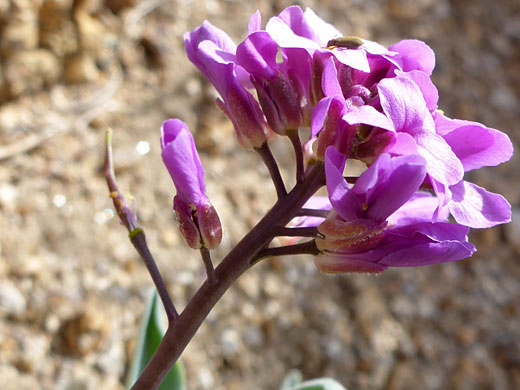Phoenicaulis Cheiranthoides, Daggerpod
Plants > Wildflowers > Brassicaceae > Phoenicaulis Cheiranthoides
Common name:
Daggerpod
Family:
Scientific name:
Phoenicaulis cheiranthoides
Main flower color:
Range:
The Pacific states, Idaho, Nevada and far northwest Utah
Height:
Up to 12 inches
Habitat:
Volcanic areas, talus, rocky hillsides; sandy or gravelly locations, from 2.300 to 9,000 feet
Leaves:
Stalked, basal and cauline, narrowly oblanceolate to lanceolate, up to 4 inches long and 2 inches wide
Season:
April to June
Phoenicaulis cheiranthoides is the only species of a monotypic genus. Plants produce one stem or several. Stems grow upwards, do not divide, and tend to be hairless, though they may have a light covering of finely branched hairs, this more likely towards the base. The grey-green leaves grow most strongly at the base, but also along the stem (numbering between 5 and 12), and they are always covered by the branched hairs, most densely for those nearer the ground. Leaves are generally narrow; those at the base tend to be widest above the middle, while stem leaves are widest at the middle or slightly below.
Flowers form in a compact cluster on top of the stem, becoming more open when in fruit. The four purplish, hairless, oblong sepals are around a fifth of an inch long, while the four pink-purple petals are up to three times this length. Six stamens project just a little way out of the corolla throat, topped by yellow anthers.
Flowers form in a compact cluster on top of the stem, becoming more open when in fruit. The four purplish, hairless, oblong sepals are around a fifth of an inch long, while the four pink-purple petals are up to three times this length. Six stamens project just a little way out of the corolla throat, topped by yellow anthers.
All Contents © Copyright The American Southwest | Comments and Questions | Contribute | Site Map



